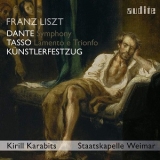 Franz Liszt: Dante Symphonie S. 109 + Künstlerfestzug zu Schillerfeier S. 114; Tasso. Lamento e Trionfo, S. 96; Staatskapelle Weimar, Knabenchor der Jenaer Philharmonie, Damen des Opernchores des Deutschen Nationaltheaters Weimar, Kirill Karabits; 1 CD Audite 97.760; Aufnahmen 2018/2019, Veröffentlichung 10/01/2020 (D), 17/01/2020 (UK, US) - (79'02) - Rezension von Remy Franck
Franz Liszt: Dante Symphonie S. 109 + Künstlerfestzug zu Schillerfeier S. 114; Tasso. Lamento e Trionfo, S. 96; Staatskapelle Weimar, Knabenchor der Jenaer Philharmonie, Damen des Opernchores des Deutschen Nationaltheaters Weimar, Kirill Karabits; 1 CD Audite 97.760; Aufnahmen 2018/2019, Veröffentlichung 10/01/2020 (D), 17/01/2020 (UK, US) - (79'02) - Rezension von Remy Franck
Franz Liszts Dante Symphonie dreht sich, wie so vieles bei diesem Komponisten, um das Göttliche und das Teuflische. Die Symphonie zu Dantes Divina Commedia hat zwei Teile, Inferno mit den Qualen der Hölle, und das zart klingende Purgatorio, wo die Seele für die Aufnahme in den Himmel gereinigt wird. Ein vom Chor gesungenes Magnificat bringt die Symphonie zu Ende.
1859 komponierte Liszt ein Werk zum hundertsten Jahrestag von Schillers Geburt. Das Stück betitelte er Künstlerfestzug, wohl wissend, dass ein solcher Festzug in Weimar nicht stattfinden würde. Seine Komposition wurde daher auch nicht aufgeführt, weswegen er sie 1860 für Klavier zu zwei und vier Händen transkribierte.
Kirill Karabits liefert von den drei Werken spannende, klangschön ausgefeilte Interpretationen; jene des Künstlerfestzugs ist eine Weltersteinspielung.
In der Dante-Symphonie verhindert er durch den feinen Klang, dass das Inferno grob und schwer klingt. Das Motiv ‘Gebt die Hoffnung auf, alle, die ihr hier eintretet’ wird orchestral feierlich und kraftvoll vorgetragen, das teuflische Rasen wird mit höchster Dramatik, aber auch mit federndem Spiel und viel Raffinement dargestellt. Im Purgatorio wirkt der Dirigent sehr inspiriert, und er trifft die Atmosphäre von diesem zweiten Satz wie auch vom abschließenden Magnificat sehr gut. Karabits gelingt eine gute Mischung von zärtlicher Versöhnung und Transzendenz. Im Magnificat entsteht eine leichte, kristalline Stimmung, und der himmlische Chor beendet das Werk mit viel Ruhe und Besinnung.
An der Interpretation der Tondichtung ‘Tasso’ ist nichts auszusetzen: die Färbungen im Orchester sind schön und stimmungsvoll, die Dramatik fehlt ebenfalls nicht, so dass wir diese zweite von Liszts dreizehn Tondichtungen in ihrer ganzen rhetorischen Kraft erleben können.
Franz Liszt’s Dante Symphony, like so many other works by this composer, revolves around the divine and the devilish. The symphony to Dante’s Divina Commedia has two parts, Inferno with the tortures of hell, and the delicately sounding Purgatorio, where the soul is purified for admission to heaven. A Magnificat sung by the choir brings the symphony to a close.
In 1859 Liszt composed a work for the centenary of Schiller’s birth. He entitled the piece Künstlerfestzug, knowing well that such a procession would not take place in Weimar. His composition was therefore not performed, which is why he transcribed it for piano two and four hands in 1860.
Kirill Karabits delivers exciting, beautifully polished interpretations of the three works; the one of the Künstlerfestzug is a world premiere recording.
With a refined sound he prevents the Dante Symphony’s Inferno from sounding coarse and heavy. The motif ‘Give up hope, all who enter here’ is solemnly and powerfully performed, the diabolical race is presented with the highest drama, but also with supple playing and much refinement. In the Purgatorio the conductor is very inspired, and his conducting of the final movement is suitably atmospheric. In the Magnificat, a light, crystalline mood is created, and the heavenly choir ends the work with much calm and reflection.
There is nothing wrong with the interpretation of the tone poem ‘Tasso’: the colours in the orchestra are beautiful and atmospheric, and the drama is not lacking either, so that we can experience this second of Liszt’s thirteen tone poems in all its rhetorical power.
























